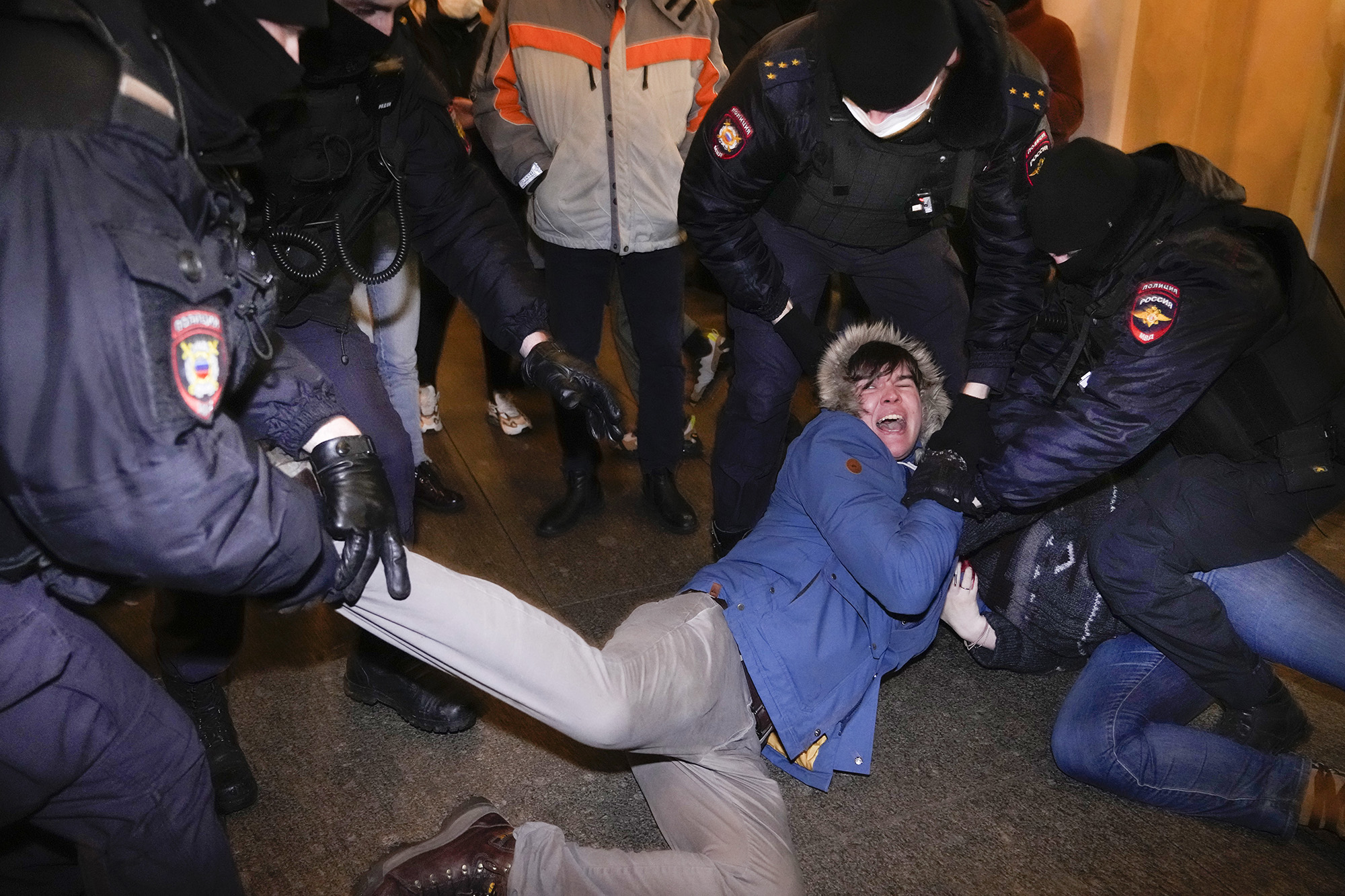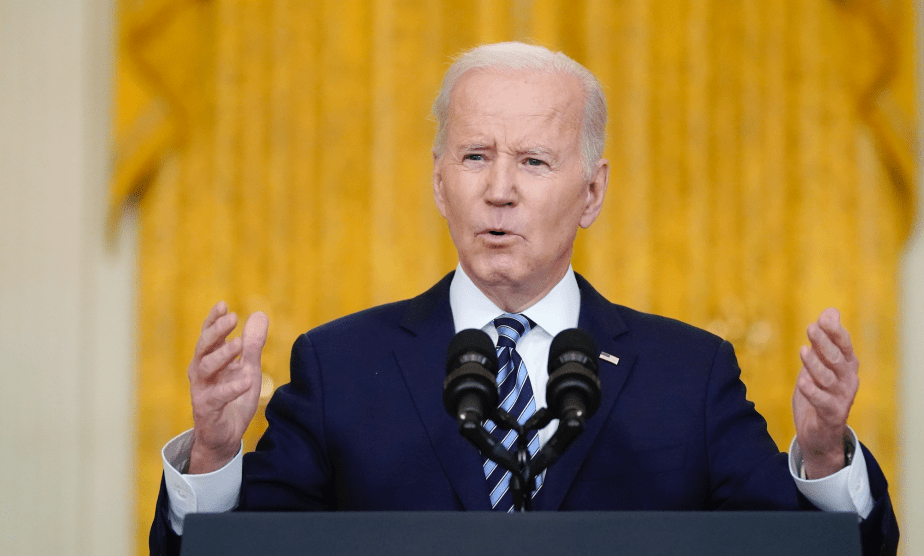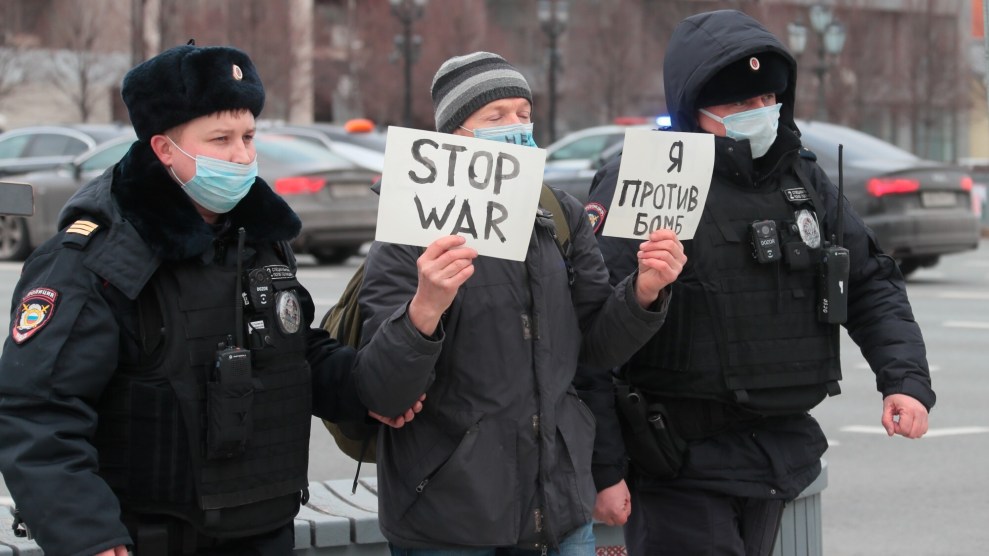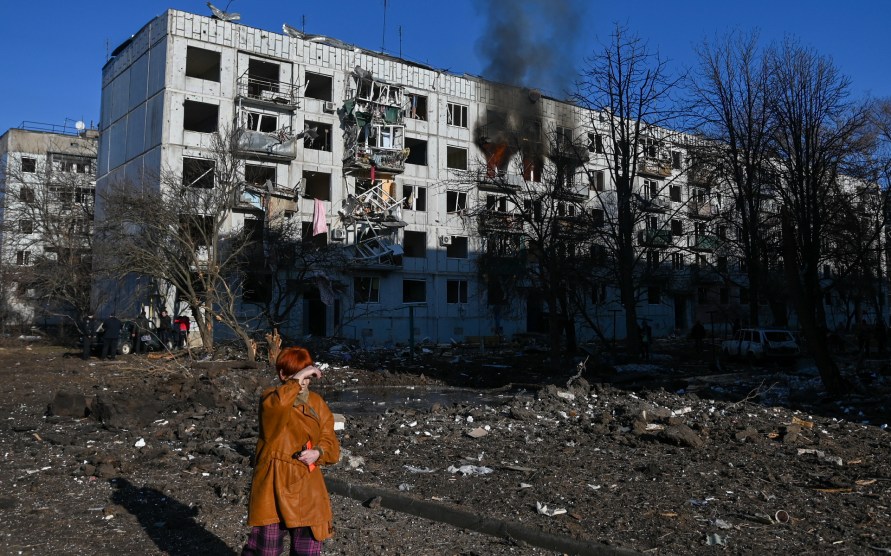On a sunny 30-degree Sunday, February 27, Svyatoslav Blokhin, a 24-year-old software developer, saw messages on Telegram channels that protests in Moscow would be starting at 4 p.m.
Blokhin had first joined in the demonstrations on February 24, when the invasion started. On that first day, he didn’t know when or where people were meeting, but he says that his heart called him to participate. “I expected other people to be on the streets,” he told me, “and they were on the streets.”
On that Sunday, Blokhin had started at a different location from the rest of the group to decrease the risk of getting detained by the police. He joined a group of people who had gathered on Novy Arbat Street, a major artery lined with high-rise offices and shopping centers. Blokhin and his wife fell in with a column of hundreds of people, some of them holding homemade signs with slogans like “Putin is a murderer,” and “Freedom for Ukraine.” They marched down the narrow Bolshoi Afanasyevski Lane to the golden-domed Cathedral of Christ the Savior, chanting “net voine,” which means “no to war,” as well as some more profane chants about Russia’s president. “There is a word ‘hooey’ in Russian, which literally translates as a ‘dick,’” Blokhin explained somewhat apologetically. “But in Russian, it sounds more brutal and more aggressive, as do all the swear words in Russian, I guess.”
At the Cathedral of Christ the Savior, the demonstrators ran into groups of Moscow police and Russian National guards, or Rosgvardiya, who started to charge and catch people, subduing them with batons. Blokhin got out of the way, joining around 350 people who crossed a bridge toward Gorky Park. From the bridge, he saw buses of police rolling in, about 1,000 according to Blokhin’s estimate. Being so outnumbered, Blokhin and his wife’s only option was to escape. “I’m angry. I’m scared, of course, and I’m nervous. But the main feeling is anger, and I want other people to join protesters on the streets.” he says. “Some people have done posts against war and Putin, but I also feel that it’s not enough. They are not listening to people on social media.”
After protesting nearly every day in addition to working full-time, he was exhausted when I caught up with him on Tuesday, but he says protesting is the only way to induce change. “I feel very sad about this situation,” he says. “We should show them that strong young Russians disagree with Putin’s politics and call other people to join.”

Strict suppression of the media has made it difficult to ascertain how the invasion has been playing in Russia, where Putin has framed it as a rescue mission to save Russian speakers from Ukrainian neo-Nazis and drug dealers. Yet even when the reprisals for speaking out are severe, the attack on Ukraine has prompted an unusual surge of outrage and acts of civil disobedience. Thousands, mostly young people in their 20s and 30s but also a few families, have taken to the streets in cities across the country to demonstrate for peace. So far about 13,000 people have been arrested in about 150 Russian cities for protesting since the start of Russia’s attacks on Ukraine. Sunday, March 6, was the largest day of protests and arrests yet. Nearly 5,000 people were detained in Moscow, St. Petersburg, and 66 other Russian cities. Most people face about 15 to 30 days in prison depending on how many times they’ve been caught at demonstrations before, but those who have been caught three times in a year may be sent to prison for up to five years.
Overwhelmed prisons, word bans, and police on every corner.@mollyfication reports from inside Putin’s full-blown crackdown on dissent: https://t.co/5nUL4sP4U9 pic.twitter.com/Y3KTcWTYAS
— Mother Jones (@MotherJones) March 8, 2022
Nikita Stoopin, 22, attended the protests in Pushkinskaya Square on February 24, the first day of the widespread invasion. The next day he was leaving a friend’s house when a car pulled up opposite the entrance and two people got out.
“They introduced themselves as criminal investigation officers and told me that I needed to go with them,” says Stoopin. “If I had run away, I could have been charged with another article that provides for up to 15 days of arrest, because of my disobedience to the lawful request of a police officer.”
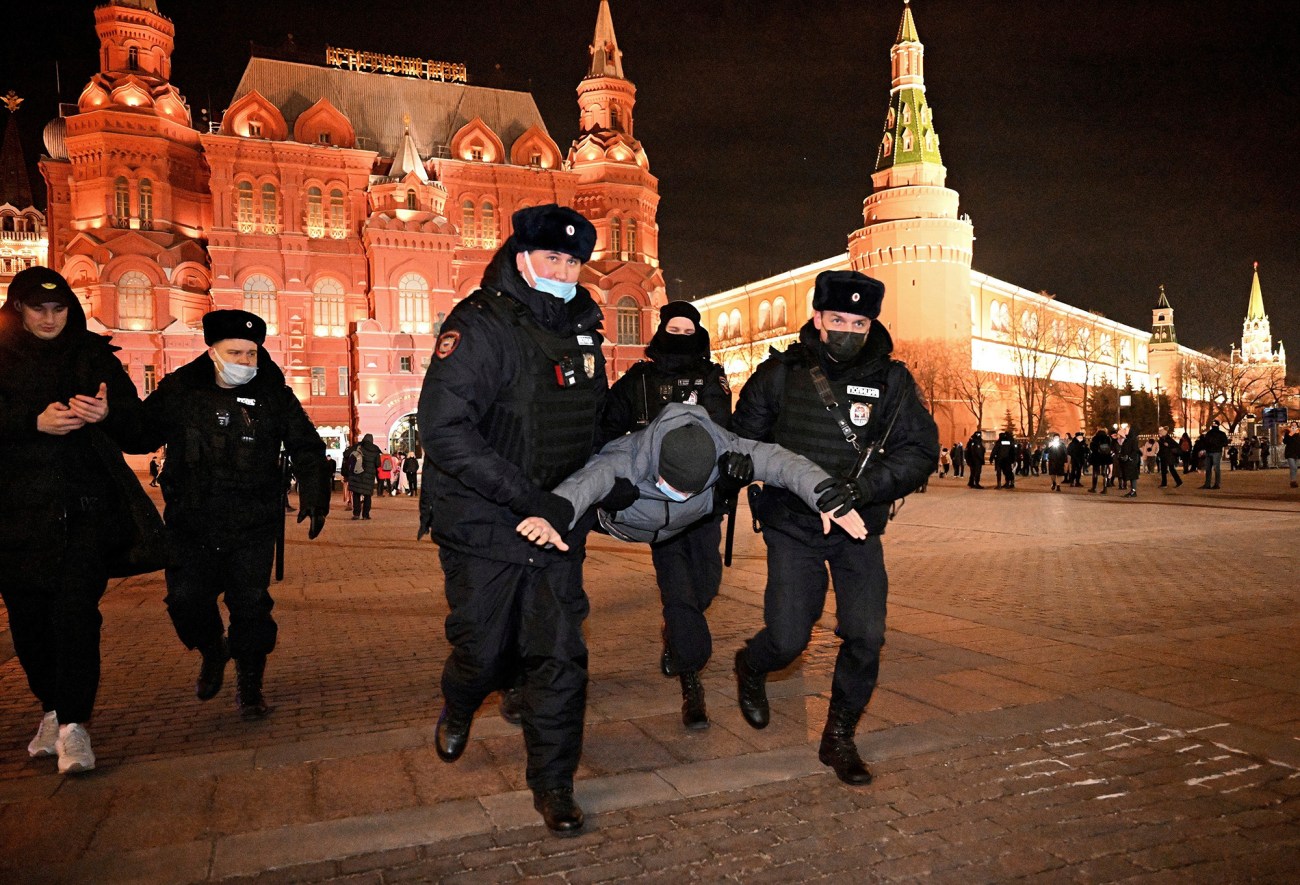
Police crack down on a protest near Manezhnaya Square in Moscow.
Alexander Miridonov/Kommersant/Sipa USA/AP
Stoopin had violated Article 20.2 of Russia’s Code of Administrative Offenses for posting on social media that people should follow a news channel that was covering the protests in Pushkinskaya Square. While in detention at the police station, his phone was taken away, so he wasn’t able to tell his friends or family where he was. He tried to look at the positive, which is that the people sitting next to him in detention were very nice. “In principle, in Putin’s Russia,” he explains, “in Putin’s Russia only nice people are arrested.”
Stoopin was in jail for five days and, during that time, he and his fellow detainees were listening to Echo of Moscow, on a Cold War independent news station, to get news from the outside world. On his last evening in detention, they heard that the Prosecutor General’s office would be blocking access to Echo of Moscow’s website and social media accounts. “And literally when they were telling it, the broadcast suddenly stopped,” says Stoopin. Later he learned that Echo of Moscow’s radio station and website had been shut down—along with other such independent news outlets as TV Rain. As Masha Gessen reported in the New Yorker, “Both media outlets were guilty of violating a ban on calling the war a war, the invasion an invasion, and the aggression aggression.”

Protests have also emerged from other, less radical quarters. More than 1.5 million people and organizations have signed a petition against the war, and doctors, nurses, and paramedics numbering more than 1,000 signed an open letter to Putin asking to end the war. “Everyone will scream in pain in the same language,” they wrote. The contemporary art museum Garage suspended any exhibits until the “human and political tragedy that is unfolding in Ukraine has ceased.” Over 17,000 Russians working in the arts and culture sector signed an open letter, saying “everything that has been done culturally over the past 30 years is now at risk.”
In #StPetersburg, #Russia, the police detained a well-known survivor of the Siege of Leningrad Yelena Osipova at an anti-war #protest: pic.twitter.com/QFhPrWKcCo
— Alex Kokcharov (@AlexKokcharov) March 2, 2022
Prominent Russians, from the Pulitzer Prize–winning editor-in-chief of Novaya Gazeta Dmitry Muratov to the popular rapper Oxxxymiron, have spoken out against the war. Even the oligarchs Oleg Deripaska and Mikhail Fridman broke their silence and made statements protesting the Russian incursion. There has been an outpouring of support for Ukraine on social media, with people adding frames to their profile pictures that say: “I am against the attacks on Ukraine.”
In response, the Russian government has enacted a full-blown crackdown on dissent. They have outlawed the use of the words for “war” and “invasion,” perpetrated DDoS attacks on news sites, and blocked access to social media like Twitter and Facebook. The state propaganda outlets, which had already pushed constant anti-Ukraine messaging since the annexation of Crimea in 2014, have gone into overdrive, adding more time slots for their propagandistic talk shows and claiming that Ukrainians are using their guns on each other, that Russian troops are carrying out a necessary humanitarian mission, and that the Americans are in charge of Ukraine’s units.
Artyom Sheynin, host of Russian propaganda talk show Vremya Pokazhet:
"The Ukrainian authorities – I suppose still formally the authorities of Ukraine – are in fact waging war with their own population in cities where there are no Russian troops, first and foremost in Kyiv" pic.twitter.com/bSJR5X4KB6
— Francis Scarr (@francska1) February 26, 2022
“We are shocked,” says Maria, 25, who is using a fake name to protect herself from years in prison by the Russian authorities for the crime of spreading fake news about the Russian army. She was originally going to use her name when she was talking to me, but then the Russian government came out with a new law that said anyone who spreads “fake news” about the Russian army—which includes using the words “war” and “invasion” to describe what’s happening in Ukraine—can spend 10 to 15 years in jail. “There was a lot of information in foreign media that Russia will attack Ukraine, and we are like, are you crazy? It can’t be real, never.”

February 24 was the day that ended any guessing about why 190,000 Russian military personnel were lined up along the border with Ukraine. The night before, Putin had recognized Donetsk and Luhansk regions of Ukraine as independent so-called people’s republics. At 6 o’clock the next morning, he announced that he had “made the decision of a military operation,” and explosions started going off in cities across the country. More than ten days after the invasion began, UNHCR recorded that 364 civilians in Ukraine have been killed and 759 injured. It has been impossible to estimate the number of Russian soldiers killed because the Russian government is actively suppressing the numbers. At one point last week, the Russian Defense Ministry said that 498 Russian soldiers had been killed, while Ukraine’s military says that the number is closer to 11,000 Russian troops.
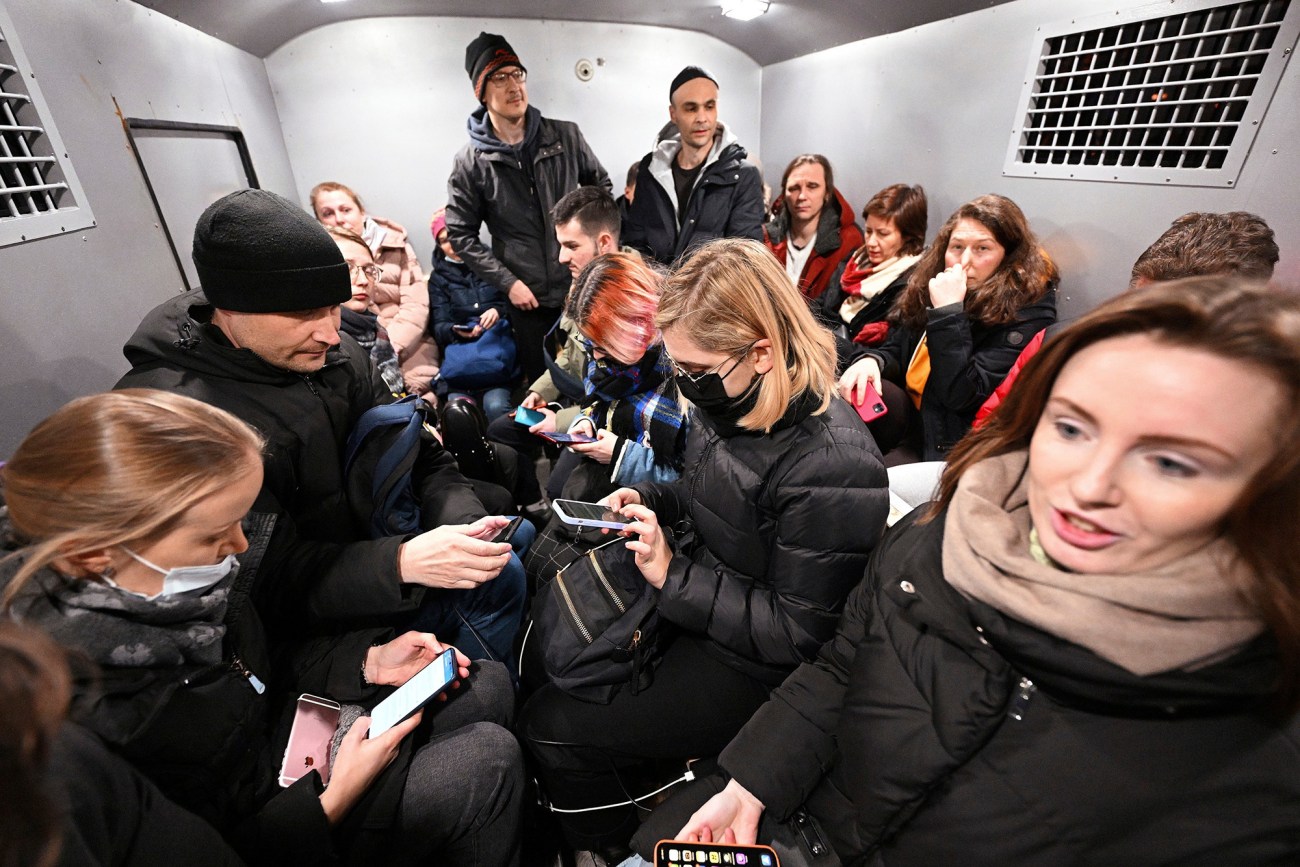
Protesters were detained and crowded in a police wagon.
Alexander Miridonov/Kommersant/Sipa USA/AP
Russian shelling in Kyiv, Kharkiv, Odesa, Kramatorsk, and Mariupol have razed buildings and left these populated cities strewn with rubble, and the city of Kherson near Crimea has fallen. There is a surging refugee crisis in Lviv as displaced Ukrainians flee toward the border with Poland. One week after the invasion began, the United Nations High Commissioner on Refugees estimated that more than 1.5 million have already left Ukraine.
Meanwhile, in Moscow, Maria says, “On every street, every five meters there is a policeman who stops us.” Ten of her friends have already been arrested. She has been to two demonstrations in Moscow, which she says have been relatively subdued, partly because all of the experienced organizers in Russia, like opposition-blogger Alexei Navalny and Open Russia founder Andrei Pivovarov, are in jail. Others, like Lyubov Sobol who is a former opposition politician, have stayed out of jail by fleeing the country earlier this year. But even from prison, last week Navalny released a remarkable Twitter thread about the leadership.
1/16 Yesterday I watched the “session of the Security Council”, this gathering of dotards and thieves (it seems to me that our Anti-Corruption Foundation has done investigations into the corruption of every single one of them).
— Alexey Navalny (@navalny) February 22, 2022
“We don’t have leaders,” says Maria. “We [find out about] a march in some chats and groups, and they can change location. It is not well-organized.”
“To be honest, there were many more at the rallies organized by Alexei Navalny,” says Stoopin, referring to previous pro-democracy rallies. “But in this case, the rallies were, let’s say, not high but wide. There were more of them. They are still continuing even today.”
Since police have closed off central gathering places, like Pushkinskaya Square and Red Square in Moscow, or Nevsky Prospekt in St. Petersburg, meeting locations are scattered and spontaneous. They are decided on in Telegram chats and shared in Instagram stories, an act which is punishable by 10 to 30 days in prison. “Police are putting twenty people in spaces where three people can sleep, so people have to stand all night,” says Kuznetsova, who describes the situation at police stations as a humanitarian crisis. “They never had so many people to arrest, so they don’t have space.”
In an OVD-Info timeline of protests and arrests in Russia, the organization estimates that the “scale of rallies is approaching a record since Putin came to power.”
But this decentralized, disorganized form of protesting does have some advantages. “If you arrest an organizer, no one can say when the next protest will be,” explains Maria Kuznetsova, the Press-Secretary of OVD-Info, a human rights organization that defends the right to assembly by helping get arrested protesters out of prison. “But because now there is no organizer, [the authorities] don’t know how to deal with that.”

Beleaguered by over 10 years of progressively harsher penalties, Russian people have fewer and fewer ways to dissent. In December 2011, the massive protests in Bolotnaya Square following Putin’s fraudulent reelection brought out tens of thousands of people. Last year, Navalny’s organization spawned protests in cities across Russia after the dissident was poisoned and then detained in Russia. Over the last year, the official crackdown cranked into overdrive, starting with the arrest of Navalny, the closure of news agencies and human rights organizations like Memorial, and the spree of accusing journalists and NGOs of being foreign agents.
“The reason why these protests are not super organized is because last year Russian authorities completely destroyed civil society,” says Kuznetsova. “Because of this crackdown on civil society, we don’t have as big protests as we could have. There is no one left in Russia who can do that anymore.”
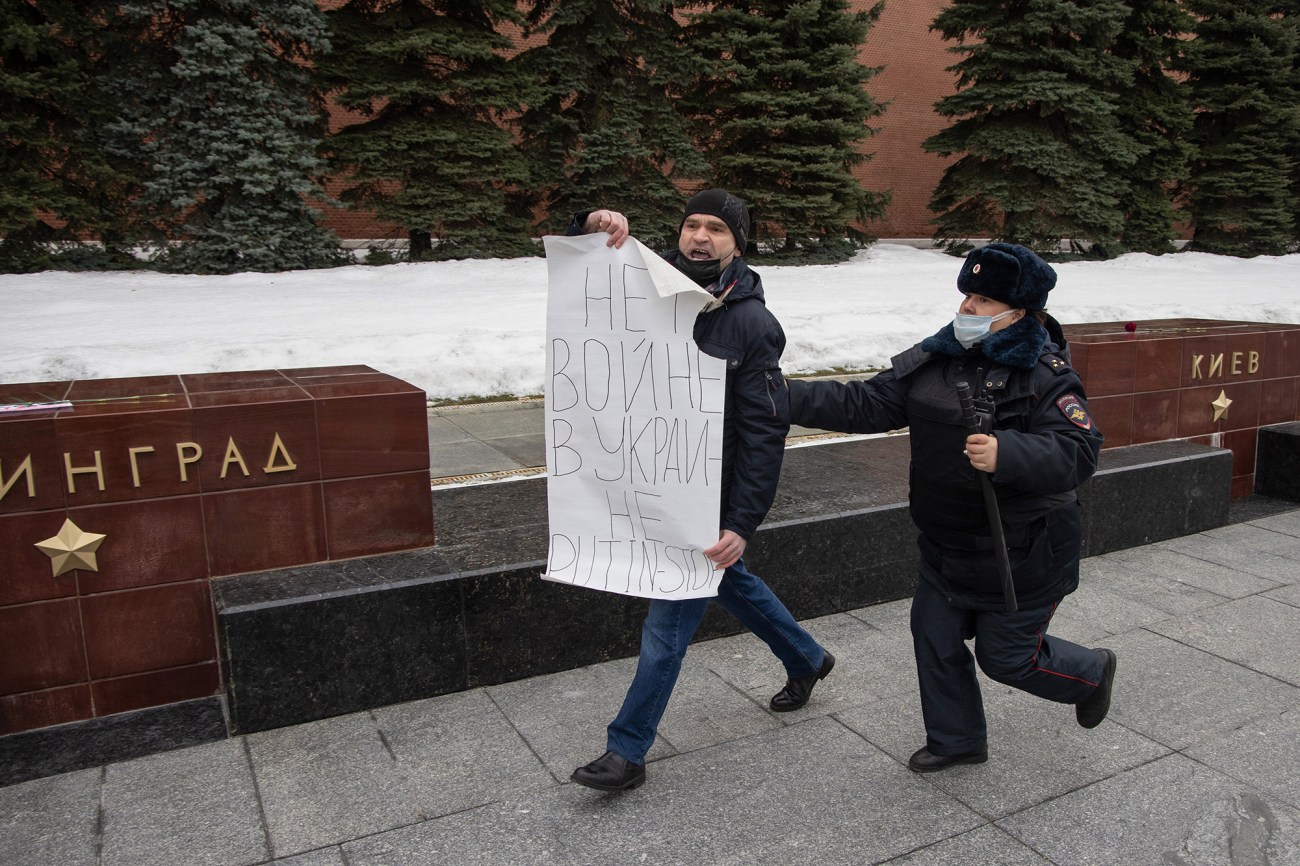
A demonstrator holds a sign reading “No War in Ukraine, Putin Stop” at the grave of the unknown soldier near the Kremlin wall in Moscow.
Andrey Rudakov/Bloomberg/Getty
Russia’s actions have resulted in a swift severing of ties with the West. The EU, the US, and the UK have implemented unprecedentedly severe sanctions on Russian banks, institutions, and individuals, including Putin himself. Air spaces across Europe have been closed to flights from Russia. Western companies, from Apple to Netflix, from BP to General Motors, are cutting ties with Russia and divesting from investments in Russian companies. As a result, the ruble has plummeted and Russian markets have been sent into free fall. Russians running to the ATMs, buying dollars, and buying flight tickets out of Russia through Istanbul. Russia’s Central Bank just introduced a 30 percent commission on the purchase of dollars, euros, and pounds on the stock exchange.
The social instability in Russia is likely to lead to more demonstrations. “There are many many little things that grow into one big lump of discontent,” says Stupin. “I think that yes, people will come out in greater numbers, even those who have not come out before.”
It has been reported that Russia’s Federation Council plans to hold a meeting during which it is expected the council will impose anti-crisis laws, or even martial law. The latest Levada poll, taken before the invasion, showed that Putin’s popularity held strong at 71 percent, with 52 percent thinking Russia is moving in the right direction. Whether he loses that support in the aftermath of his campaign in Ukraine remains to be seen.
For the young Russians going out into the streets, the idea that a majority of their country supports Putin seems unfathomable. “The Russian population mostly does not want any war, and we’re doing basically all we can to let the whole world know it,” says Stoopin. “Some Russians indeed think war is needed, but they’re just watching way too much TV.”
But like so many of us, Stoopin lives in a bubble. Michael Wasiura is an American journalist who has had an inside look at the Russian domestic propaganda machines. For the past five years, he worked as a guest host on aggressively patriotic talk shows on Russian state TV, where his job was to represent the “liberal American” viewpoint. He says that any outrage at the war among the pro-Putin factions was short-lived. Based on observations among his extended family and social circles in Russia, he noticed that some people who support the regime came out briefly against the war, but they’ve mostly fallen in line. Now they range from patriotic supporters of the “denazification” of Ukraine to politically apathetic.
“People who were against the regime are still against the regime, and people who were ‘a-political’ before think they’re being brave by posting ‘no to war’ on Instagram,” Wasiura says. “Even in Moscow’s upper-middle-class circles, there’s still plenty of outright support for the invasion.” Wasiura also points out that the economic stress that many Russians are sure to experience in the coming months may only serve to reinforce the victim mentality that Putin has promoted vis-a-vis Russia and the West.
“The overwhelming majority of Russians,” he says, “is prepared to blame their sudden poverty on anyone other than their own leaders.”
Young Russians like Blokhin never experienced life in the Soviet Union, never witnessed the gulags and the repression. But now as the international isolation and internal repression has increased, his vision of the future has to contend with these problems of the not-so-distant past. “I don’t want our country to be isolated. I don’t want our country to be violent. I don’t want our country to be not attractive to other countries,” says Blokhin. “But it’s what’s happening. And we share responsibility for what is happening in Ukraine.”
